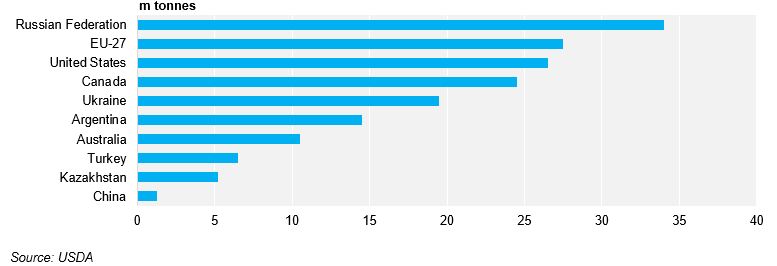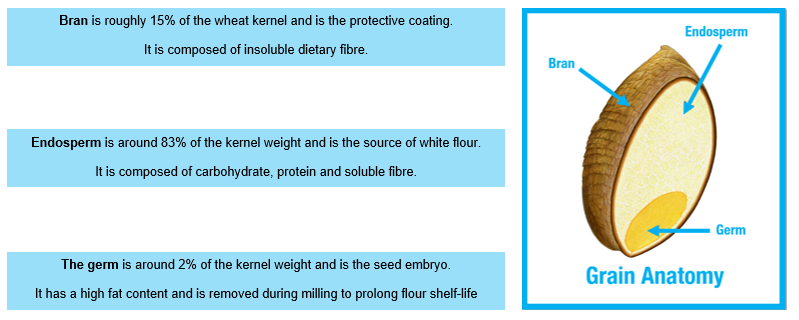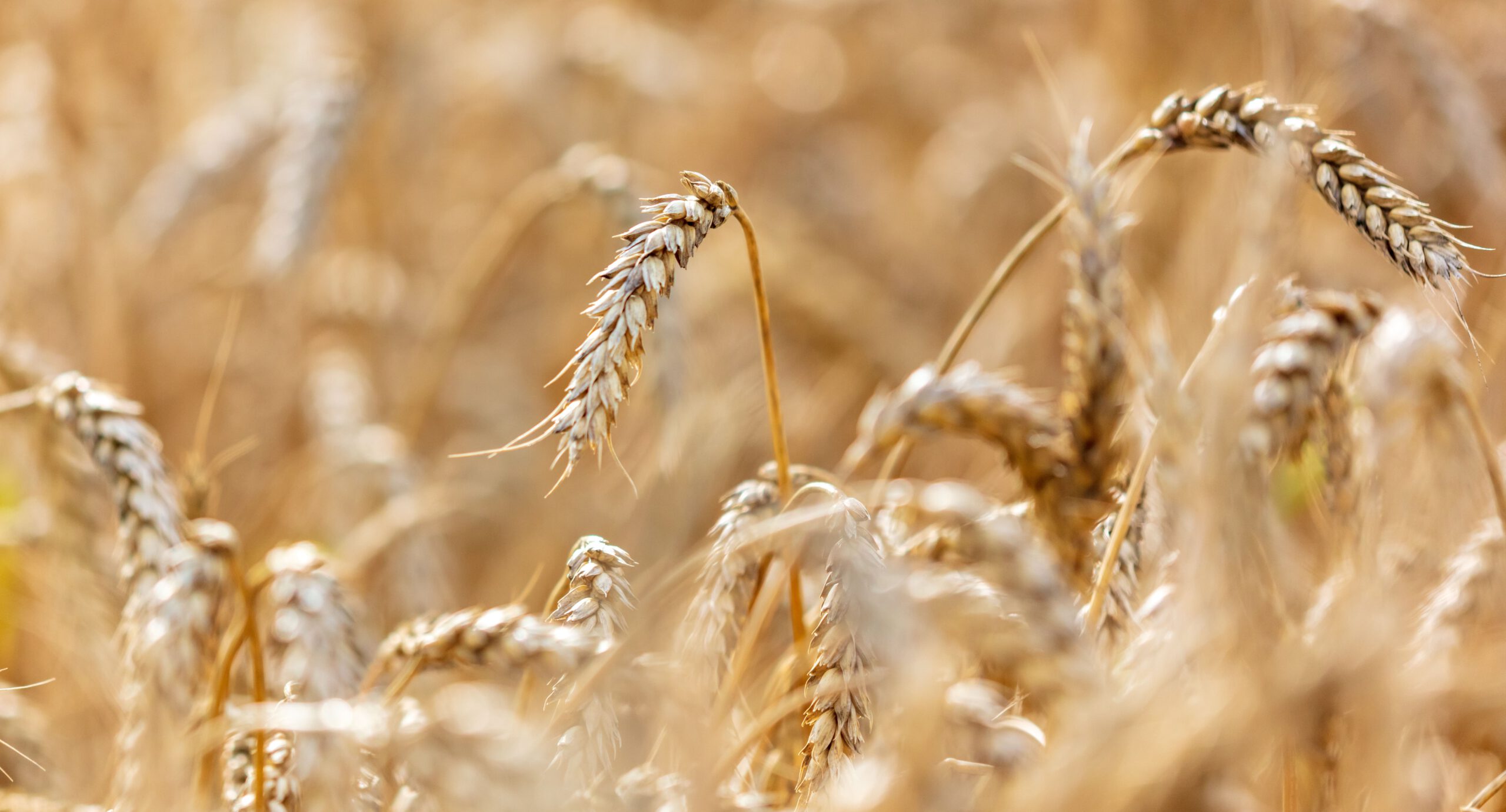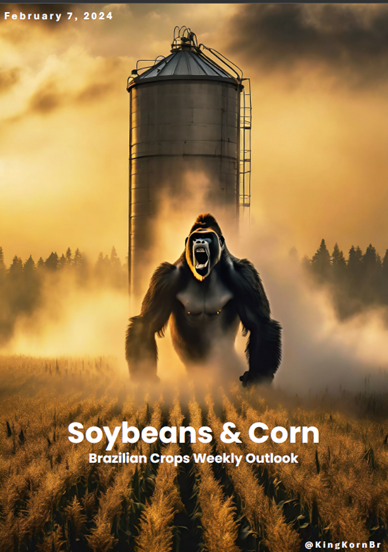1,056 words / 6.5 minute reading time
The Basics
- Grains are a concentrated form of carbohydrates and protein that can be easily cultivated and stored.
- They have therefore played a key role in human nutrition for centuries.
- They continue to provide the majority of the calorific intake for much of the world’s population, either through direct consumption or through animal feed.
Worldwide Production of Grain by Type in 2018/19

- Wheat is the second most-produced grain in the world after corn, and has traditionally been the most important grain for the Middle East and Europe.
- However, it has now spread across the globe, with the largest producers of wheat mirroring the most populous countries in temperate regions.
- Compared to other cereals, wheat can be a demanding crop; it is susceptible to disease in warm, humid regions and grows best in a cool climate.
Top 10 Producers of Wheat

- The top producing nations are also the world’s major consumers of wheat.
Top Wheat Consumers

Top Wheat Exporters

- Without wishing to state the obvious, wheat is used for baking (raised and unleavened breads, cakes, pastries, biscuits), brewing (beer) and as an animal feed.
The Wheat Kernel

Wheat Classification
- Around 30,000 varieties of wheat are known and can be classified according to planting schedule, endosperm composition, and kernel colour.
Planting Schedule
- Spring wheat is fast-growing and is typically planted in early spring once the soil temperature is above 8 degrees Celsius. It is commonly found in more mild climates. It is generally harvested in August in Northern Hemisphere countries.
- Winter wheat is planted in autumn/fall to germinate ahead of winter, before entering a vegetative state. It resumes growth in the spring. It is harvested in June/July in the Northern Hemisphere.
Endosperm Composition
- Hard and soft wheats are classified according to the mechanical strength of the kernel, which itself is a function of the amount of protein relative to starch in the endosperm.
- The majority of the protein in wheat is referred to as gluten. It is both plastic and elastic: it can stretch under pressure, yet at the same time resists that pressure.
- For example, it expands to accommodate gases which form during fermentation, but also contains those gases. This makes raised breads possible.
- Hard wheats have a higher protein content than other wheats. They are primarily used to make food which require gluten such as breads, pizza dough and pasta.
- Durum is the hardest wheat and is used most often for pasta.
- Soft wheats are used for all-purpose flour, cakes, biscuits, and foods which require a more crumbly texture.
Colour
- Wheats can also be categorised by the colour of the kernel bran.
- White wheat is lighter in colour and milder in flavour as it has fewer phenolic compounds.
- Other colour wheats such as red wheats often need bleaching. The exception is during pasta manufacture, where a yellow tint is desirable.
Major Wheat Futures Markets
Wheat is traded on the following major commodity exchanges:
- Minneapolis Hard Red Spring Wheat
- Contract unit: 5,000 bushels (approx. 136 metric tonnes)
- Price quotation: US dollars and cents per bushel
- Minimum price fluctuation: 1/4 cent per bushel or $12.50 per contract
- Delivery months: March, May, July, September and December
- Physical specifications: USDA No. 2 or better Dark Northern or Northern Spring Wheat with a protein content of 13.5% or higher, with 13.0% to 13.4% protein deliverable at a discount.
- Settlement method: Physical delivery
- Kansas Hard Red Winter Wheat
- Contract Unit: 5,000 bushels
- Price Quotation: US dollars and cents per bushel
- Minimum price fluctuation: 1/4 cent per bushel or $12.50 per contract
- Delivery months: March, May, July, September and December
- Physical specification: Deliverable grades of HRW shall contain a minimum 11% protein level. However, protein levels of less than 11%, but equal to or greater than 10.5% are deliverable at a ten-cent (10¢) discount to contract price. Protein levels of less than 10.5% are not deliverable.
- Settlement method: Physical delivery
- Chicago Soft Red Winter Wheat
- Contract unit: 5,000 bushels
- Price Quotation: US dollars and cents per bushel
- Minimum price fluctuation: 1/4 cent per bushel or $12.50 per contract
- Delivery months: March, May, July, September and December
- Physical specification: No. 2 Soft Red Winter at contract price, No.1 Soft Red Winter at a 3 cent premium, other deliverable grades listed in Rule 14104
- Settlement method: Physical delivery
- Paris Milling Wheat
- Contract units: 50 metric tonnes
- Price quotation: Euro and Euro cent per metric tonne
- Minimum price fluctuation: 25 Euro cents per metric tonne
- Delivery Months: September, December, March, June such that 12 delivery months are available for trading
- Physical specification: 15% moisture, 76 kilograms per hectolitre weight (kg/hl)
- Settlement method: Physical delivery
- London Feed Wheat
- Contract units: 100 metric tonnes
- Price Quotation: Pounds and pence per metric tonne
- Minimum price fluctuation: 5 pence per metric tonne
- Delivery months: January, March, May, July, November such that 10 delivery months are available for trading
- Physical specification: 15% moisture, 72.5kg/hl
- Settlement method: Physical Delivery
- Black Sea Wheat
- Contract unit: 50 metric tonnes
- Price quotation: US Dollars and cents per metric tonne
- Minimum price fluctuation: $0.25 per metric tonne
- Contract months: 15 consecutive months listed
- Physical specification and pricing basis: The Floating Price for each contract month shall be equal to the arithmetic average of the “FOB Black Sea wheat (Russia, 12.5%)” price assessment published by Platts for each day that it is determined during the contract month. The Floating Price shall be rounded to the nearest $0.01.
- Settlement method: Financially settled
- Australian Wheat Futures
- Contract units: 50 metric tonnes
- Price quotation: US Dollars and cents per metric tonne
- Minimum price fluctuation: 0.25 cents per metric tonne
- Contract months: 12 consecutive months listed
- Physical specification and pricing basis: The Floating Price for each contract month is equal to the average price calculated for all available price assessments published for “APW Wheat FOB Australia” by Platts during the contract month rounded to the nearest $0.25.
- Settlement method: Financially settled





